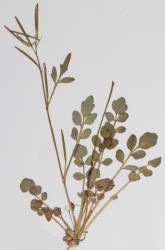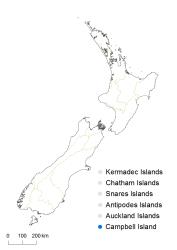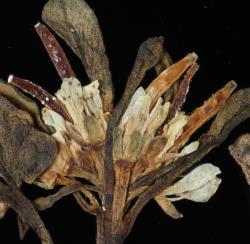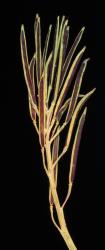- ≡ Cardamine hirsuta var. subcarnosa Hook.f., Bot. Antarct. Voy. I. (Fl. Antarct.) Part I, 5 (1844)
- ≡ Cardamine glacialis var. subcarnosa (Hook.f.) O.E.Schulz, Bot. Jahrb. Syst. 32: 542 (1903)
Perennial herb, caespitose, forming an open rosette. Leaves pinnatisect, up to 100(–140) mm long, green, glossy, subcoriaceous, lamina and petiole margins sparsely ciliate, glabrate, or occasionally glabrous; petiole 20–40(–60) mm long, 1.5–6.0 mm wide, winged and sheathing at base; hydathodes inconspicuous to prominent. Terminal pinna 5–25 × 5–20 mm, orbicular to broadly elliptic, with inconspicuous lateral lobes or shallowly toothed, apex obtuse to rounded, base cuneate, obtuse or ± truncate. Lateral pinnae 5–7, 3–22 × 2.5–12 mm, usually in pairs although proximal leaflets occasionally alternate, usually not overlapping except occasionally the uppermost pair and the terminal, broadly elliptic, elliptic to obovate, shallowly toothed or entire; petiolules up to 10 mm long, although sometimes ± absent, apex obtuse to rounded, base cuneate, obtuse or ± truncate. Cauline leaves subtending pedicels, although sometimes absent on upper pedicels; lower leaves similar to rosette leaves, but with fewer and narrower leaflets, becoming smaller in all parts; upper leaves 1.7–6.5 × 0.3–0.9 mm, increasingly linear, simple. Inflorescence 50–150(–300) mm long, 1.2–1.6 mm diam. at base, glabrous, usually elongating after flowering, upright to ascending, racemose, flowers distant in upper half. Pedicels 2.0–12 mm long, 0.5–0.8 mm diam, erecto-patent to spreading. Sepals 1.3–2.4 × 0.7–1.2 mm, oblong to elliptic, glabrous, green or purple, margin white and membranous, apex obtuse to rounded, base truncate. Petals 2.2–4.5 × 0.6–1.3 mm, white, pink or purple, usually purple veined, limb obovate; apex obtuse to rounded; base cuneate to attenuate, tapering to a ± indistinct claw, claw up to 0.5 mm long. Stamens 6; median filaments 4, 1.9–2.2 mm long; lateral filaments 2, 1.6–1.9 mm long; anthers 0.3–0.4 mm long. Ovary 3.2–3.5 mm long, 0.5–0.7 mm diam., terete, glabrous; stigma 0.3–0.5 mm diam. Siliques 9–20 × 0.9–1.3 mm, glabrous, not crowded, erecto-patent to spreading, style 1.0–1.4 mm long; replum 0.3–0.4 mm wide. Seeds 0.8–1.4 mm long, 0.5–0.9 mm wide, 0.3–0.5 mm thick, orbicular-oblong or oblong, red-brown; wing absent.
Cardamine subcarnosa grows in damp places on scree, peat, grassland, and rock crevices. Noted by Meurk et al. (1994) as being most common in herbfields, tall Marsippospermum rushlands, and fellfields of the summit tundra zone.
Cardamine subcarnosa is assessed as having a conservation status of At Risk—Naturally Uncommon, with the qualifiers Island Endemic and One Location (de Lange et al. 2018).
Flowering November–February; Fruiting December–February.







